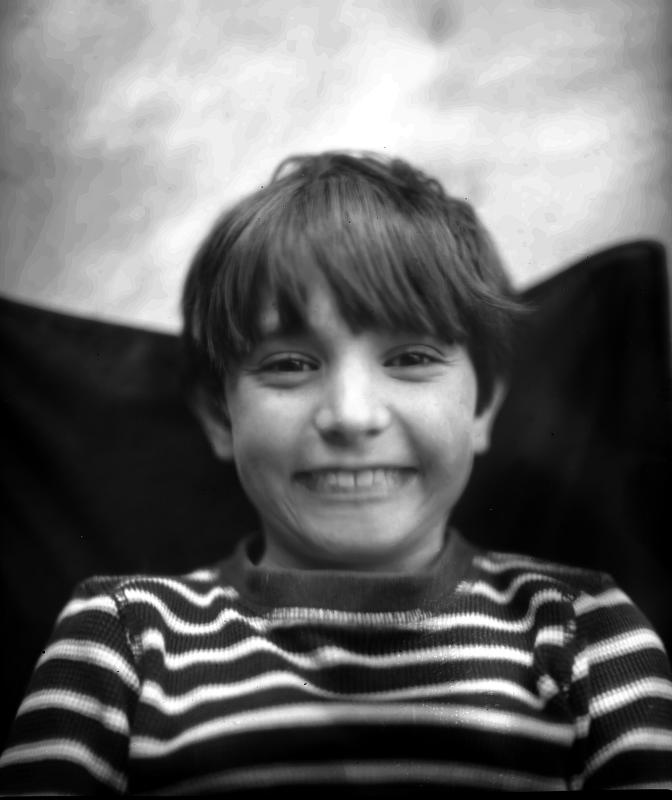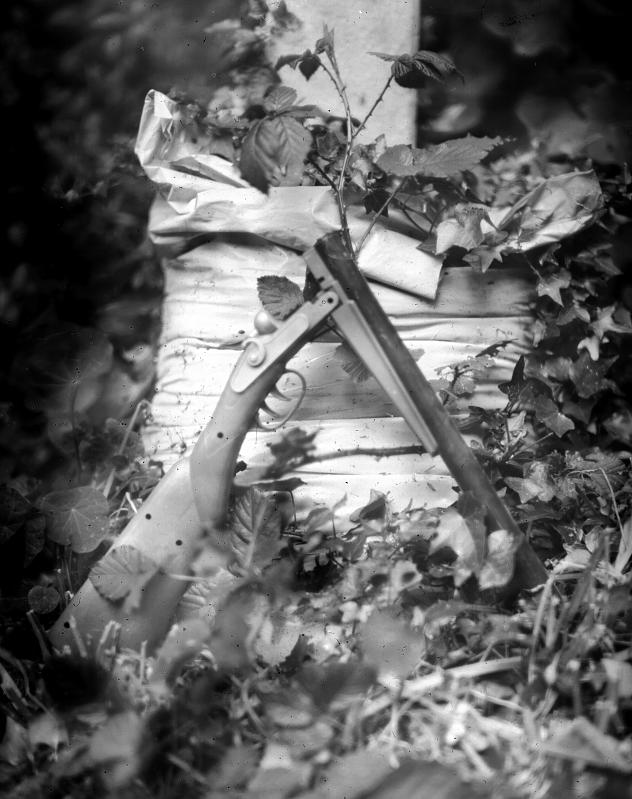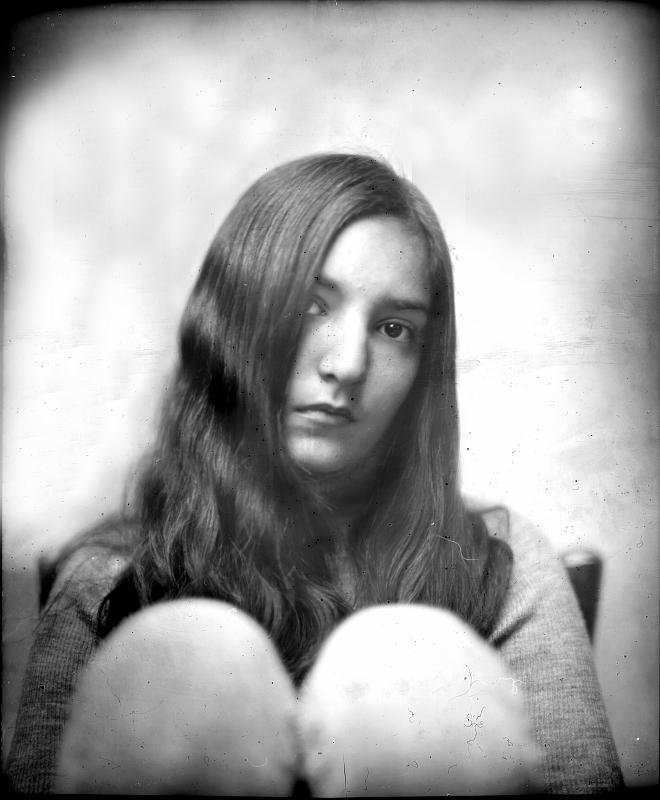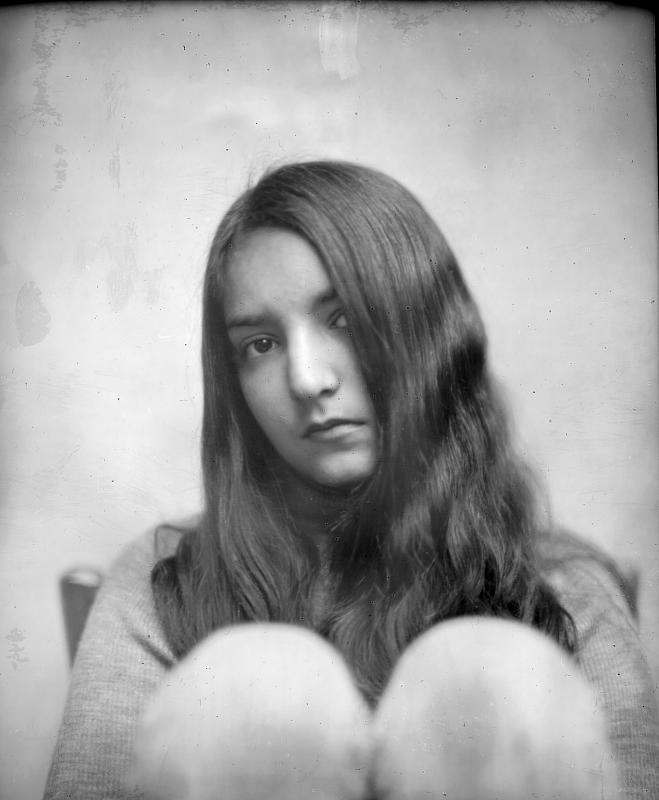| View previous topic :: View next topic |
| Author |
Message |
luisalegria


Joined: 07 Mar 2008
Posts: 6602
Location: San Francisco, USA
Expire: 2018-01-18
|
 Posted: Sun May 09, 2010 6:32 am Post subject: Meridian Field Camera, Zeiss Biotessar, Kodak Polycontrast Posted: Sun May 09, 2010 6:32 am Post subject: Meridian Field Camera, Zeiss Biotessar, Kodak Polycontrast |
 |
|
luisalegria wrote:
I picked up a couple of boxes of long-expired Kodak Polycontrast paper at a garage sale for nothing about a year ago - you never know when you will want this stuff !
So I have been working on a roll film camera to use my quite rare Zeiss Biotessar 2.8/16.5cm lens, which is mounted for 4x5, and I thought that, well, photo paper could indeed serve as film, and though I don't want to develop 4x5 film, photo paper is much less troublesome. So I cut up some paper into 4x5 and loaded some holders for my father-in-laws old 4x5 Meridian field camera. I ordered some cheap Foma developer and Fixer from Freestyle photo. The idea is to shoot negatives on paper, then scan and invert digitally.
Kodak Polycontrast is pretty much ISO 6. Thats a very slow "film", but with the f/2.8 Biotessar its just right for daylight portraits wide open.
It works rather well I think; "film" flatness is a problem, but it always is on this anyway. With the Biotessar's very shallow DOF I will have to remember to focus just a bit in front of where I want the point of focus to be.



_________________
I like Pentax DSLR's, Exaktas, M42 bodies of all kinds, strange and cheap Japanese lenses, and am dabbling in medium format/Speed Graphic work. |
|
| Back to top |
|
 |
poilu

Joined: 26 Aug 2007
Posts: 10472
Location: Greece
Expire: 2019-08-29
|
 Posted: Sun May 09, 2010 6:44 am Post subject: Posted: Sun May 09, 2010 6:44 am Post subject: |
 |
|
poilu wrote:
wow! crazy experiment and impressive results 
6 ISO and just right for daylight  
_________________
T* |
|
| Back to top |
|
 |
Scheimpflug


Joined: 06 Feb 2010
Posts: 1888
Location: New Zealand / USA
Expire: 2011-11-18
|
 Posted: Sun May 09, 2010 7:06 am Post subject: Posted: Sun May 09, 2010 7:06 am Post subject: |
 |
|
Scheimpflug wrote:
What a clever idea! I love the "vintage" look. 
How many 4x5 sheets can you get out of your paper supply?
_________________
Sigma DP1, Nikon D40 (hers  ), Polaroid x530, Pentax P30t, Pentax P50, (P30t/P50 K-A to Nikon F body mount conversion) ), Polaroid x530, Pentax P30t, Pentax P50, (P30t/P50 K-A to Nikon F body mount conversion)
Nikon: 18-55/3.5-5.6 "G ED II DX" (F) Soligor: 28/2.8 (FL->F converted), 135/3.5 (F), 3x TC (F, modified) Kalimar: 28-85/3.5 (F)
Vivitar: 70-210/2.8-4.0 Version 3 (F), Tele 500/6.3 Preset (F), 19/3.8 (F) Minolta: 300/5.6 (SR/MC/MD pending F conversion)
Tamron: 28/2.8 (Adaptall) Panagor: 28/2.5 (FD) Aetna: 300/5.6 (F) Osawa: MC 28/2.8 (F)
Vintage Lenses: Dallmeyer: 1940s A.M. 14in 356mm f4 (ULF->M42) 1930s Adon Telephoto Taylor, Taylor & Hobson: 1880s Rapid Rectilinear 8 1/2 x 6 1/2 11.31in f/8 (LF->?)
Parts Lenses: Nikon 35-135/3.5-4.5 (F), Sigma 70-210/4.5 (F), Nikon 50/1.8 Series E (F) |
|
| Back to top |
|
 |
kansalliskala


Joined: 19 Jul 2007
Posts: 5044
Location: Southern Finland countryside
Expire: 2016-12-30
|
 Posted: Sun May 09, 2010 7:25 am Post subject: Posted: Sun May 09, 2010 7:25 am Post subject: |
 |
|
kansalliskala wrote:
Nice techique and results!
What was the exposure time?
_________________
MF: Kodak DCS SLR/c; Samsung NX10; OM-10; Canon T50
Zuiko 28/3.5, Distagon 35/2.8; Yashica ML 50/2;
Zuiko 50/1.4; S-M-C 120/2.8; Zuiko 135/3.5; 200/5;
Tamron AD1 135/2.8, Soligor 180/3.5; Tamron AD1 300/5.6
Tamron zooms: 01A, Z-210
Yashicaflex C; Київ 4 + Юпитер 8, 11; Polaroid 100; Olympus XA; Yashica T3
Museum stuff: Certo-Phot; Tele-Edixon 135; Polaris 90-190; Asahi Bellows; Ixus IIs
Projects: Agfa Isolette III (no shutter), Canon AE-1D (no sensor),
Nikon D80 (dead), The "Peace Camera"
AF: Canon, Tokina, Sigma Video: JVC GZ-MG275E |
|
| Back to top |
|
 |
PaulC


Joined: 23 Dec 2008
Posts: 2318
|
 Posted: Sun May 09, 2010 8:04 am Post subject: Posted: Sun May 09, 2010 8:04 am Post subject: |
 |
|
PaulC wrote:
Very clever! It certainly does give a retro look.
_________________
View or buy my photos at:
http://shutterstock.com/g/paulcowan |
|
| Back to top |
|
 |
Nesster


Joined: 24 Apr 2008
Posts: 5883
Location: NJ, USA
Expire: 2014-02-20
|
 Posted: Sun May 09, 2010 11:26 am Post subject: Posted: Sun May 09, 2010 11:26 am Post subject: |
 |
|
Nesster wrote:
Excellent results, thanks for showing us the experiment.
_________________
-Jussi
Camera photos
Print Photographica
|
|
| Back to top |
|
 |
luisalegria


Joined: 07 Mar 2008
Posts: 6602
Location: San Francisco, USA
Expire: 2018-01-18
|
 Posted: Sun May 09, 2010 3:48 pm Post subject: Posted: Sun May 09, 2010 3:48 pm Post subject: |
 |
|
luisalegria wrote:
I have two boxes of 8x10 photo paper, one was open when I got it with some sheets missing, so thats about 180 sheets of 8x10. I cut each 8x10 into four 4x5 sheets, thats potentially 720 pieces of 4x5 "film".
If I recall correctly, exposure times at f/2.8 were 1/15-1/25. The Biotessar is in a very old Compound shutter, the speeds are continuously variable but marked in the old style, 1/10, 1/25, etc.
_________________
I like Pentax DSLR's, Exaktas, M42 bodies of all kinds, strange and cheap Japanese lenses, and am dabbling in medium format/Speed Graphic work. |
|
| Back to top |
|
 |
F16SUNSHINE


Joined: 20 Aug 2007
Posts: 5486
Location: Left Coast
Expire: 2011-11-18
|
 Posted: Sun May 09, 2010 4:48 pm Post subject: Posted: Sun May 09, 2010 4:48 pm Post subject: |
 |
|
F16SUNSHINE wrote:
Great idea and lovely interesting images. Is the iso (equivelent ) marked on the box?
At home I have several boxes of expired paper.
This could be a fun experiment to do with my nieces and nephews.
They don't yet have patience to develop film but love to watch the image form on paper when developing.
Thanks Luis for this inspiration.
Oh BTW I envy you this lens 
_________________
Moderator |
|
| Back to top |
|
 |
marty

Joined: 09 Apr 2009
Posts: 767
Location: Italy
|
 Posted: Sun May 09, 2010 5:19 pm Post subject: Posted: Sun May 09, 2010 5:19 pm Post subject: |
 |
|
marty wrote:
Hi, there.
Impressive results, Luis. I was thinking it could be possible to contact print the paper neg on another sheet and getting a positive, some testing involved, of course, but should work.
Cheers, M.-
_________________
Canon FD
Bodies: AT-1, A-1, T-90
Lenses: nFD 20mm f2.8, 24 f2.8, 28 f2.8, 35 f2, FD 50 f1.8 S.C., 85 f1.8, 100 f2.8, 135 f2.8, 200 f4, 300 f4
|
|
| Back to top |
|
 |
F16SUNSHINE


Joined: 20 Aug 2007
Posts: 5486
Location: Left Coast
Expire: 2011-11-18
|
 Posted: Sun May 09, 2010 5:35 pm Post subject: Posted: Sun May 09, 2010 5:35 pm Post subject: |
 |
|
F16SUNSHINE wrote:
Marty
how would you project it onto the sheet to make a positive?
_________________
Moderator |
|
| Back to top |
|
 |
marty

Joined: 09 Apr 2009
Posts: 767
Location: Italy
|
 Posted: Sun May 09, 2010 5:54 pm Post subject: Posted: Sun May 09, 2010 5:54 pm Post subject: |
 |
|
marty wrote:
I would contact print. Blank sheet at the bottom emulsion up, negative on top emulsion down. A sheet of glass on top of all to keep everything flat.
The light is traveling through the back of the neg, no mistake.
Simple as that. You can expose on the enlarger baseboard, but even a bare bulb hanging from its wire would do.
Cheers, M.-
_________________
Canon FD
Bodies: AT-1, A-1, T-90
Lenses: nFD 20mm f2.8, 24 f2.8, 28 f2.8, 35 f2, FD 50 f1.8 S.C., 85 f1.8, 100 f2.8, 135 f2.8, 200 f4, 300 f4
|
|
| Back to top |
|
 |
luisalegria


Joined: 07 Mar 2008
Posts: 6602
Location: San Francisco, USA
Expire: 2018-01-18
|
 Posted: Sun May 09, 2010 6:09 pm Post subject: Posted: Sun May 09, 2010 6:09 pm Post subject: |
 |
|
luisalegria wrote:
It will project well right through the print paper ? I suppose if its mounted emulsion to emulsion there will be no detail loss.
I need to try that.
_________________
I like Pentax DSLR's, Exaktas, M42 bodies of all kinds, strange and cheap Japanese lenses, and am dabbling in medium format/Speed Graphic work. |
|
| Back to top |
|
 |
Jesito


Joined: 24 Aug 2007
Posts: 5745
Location: Olivella, Catalonia, (Spain)
Expire: 2015-01-07
|
 Posted: Sun May 09, 2010 6:19 pm Post subject: Posted: Sun May 09, 2010 6:19 pm Post subject: |
 |
|
Jesito wrote:
| marty wrote: |
Hi, there.
Impressive results, Luis. I was thinking it could be possible to contact print the paper neg on another sheet and getting a positive, some testing involved, of course, but should work.
Cheers, M.- |
Yes, it works.
We used to so when using the homemade pinholes with my children.
Paper works both as a negative film and positive output.
We used to sandwich the negative with an unexposed piece of sensible paper between two pieces of glass and kept in place with clamps (the ones used to keep papers togheter).
Exposed to the direct sunlight.
Results were quite contrasted and not too sharp, but nice as a learning experiment.
The digital approach above looks much simpler and effective.
Regards.
Jes.
_________________
Jesito, Moderator 
Jesito's backsack:
Zooms Sigma 70-300, Tamron 35-135 and 70-210 short, 70-210 long, 28-70 CF Macro, 35-70, 35-80, Vivitar 70-210 KA, Tamron 70-250.
Fixed Industar-50, , Tamron 24mm, Tamron 135mm, Sands Hunter 135mm, Pancolar 50mm, Volna-3, many Exakta lenses
DSLR SIGMA SD9 & SD14, EOS 5D, Sony A700 and NEXF3, Oly E-330, E-400, E-450, E-1
TLR/6x6/645 YashicaMat, Petri 6x45, Nettar, Franka Solida, Brilliant
SLR Minolta X300, Fuji STX II, Praktica VLC3, Pentax P30t, EXA500, EXA 1A, Spotmatic(2), Chinon CM-4S, Ricoh, Contax, Konica TC-X , Minolta 5000, 7000i, 3Sxi, EOS 500 and CX
Rangefinders Chinon 35EE, Konica C35 auto, Canonet 28, Yashica Lynx, FED-2, Yashica electro 35, Argus C3 & C4, Regula Cita III, Voigtlander Vitoret (many), Welta Welti-I, Kodak Signette 35, Zorki-4, Bessa-R & L, Minolta Weathermatic, olympus XA2
Compact Film Konica C35V, Voigtlander Vitorets, Canon Prima Super 105, Olympus XA2 and XA3
Compact Digital Olympus C-5050, Aiptek Slim 3000, Canon Powershot A540, Nikon 5200, SIGMA DP1s, Polaroid X530, IXUS55, Kodak 6490, Powershot G9 and G10
CSCCanon EOS-M, Samsung NX100 and NX210, Lumix G5, NEX-F3 |
|
| Back to top |
|
 |
marty

Joined: 09 Apr 2009
Posts: 767
Location: Italy
|
 Posted: Sun May 09, 2010 6:19 pm Post subject: Posted: Sun May 09, 2010 6:19 pm Post subject: |
 |
|
marty wrote:
I've not actually tried this but the light indeed travels through the back of the paper. When I was a beginner at printing I mistakenly put the paper upside down under the enlarger and exposed through the back. What I got was a grossly underexposed print. So I'm guessing that with the right exposure should work fine.
Cheers, M.-
_________________
Canon FD
Bodies: AT-1, A-1, T-90
Lenses: nFD 20mm f2.8, 24 f2.8, 28 f2.8, 35 f2, FD 50 f1.8 S.C., 85 f1.8, 100 f2.8, 135 f2.8, 200 f4, 300 f4
|
|
| Back to top |
|
 |
F16SUNSHINE


Joined: 20 Aug 2007
Posts: 5486
Location: Left Coast
Expire: 2011-11-18
|
 Posted: Sun May 09, 2010 7:03 pm Post subject: Posted: Sun May 09, 2010 7:03 pm Post subject: |
 |
|
F16SUNSHINE wrote:
I love this thread. Such great ideas to try. 
_________________
Moderator |
|
| Back to top |
|
 |
Scheimpflug


Joined: 06 Feb 2010
Posts: 1888
Location: New Zealand / USA
Expire: 2011-11-18
|
 Posted: Sun May 09, 2010 11:19 pm Post subject: Posted: Sun May 09, 2010 11:19 pm Post subject: |
 |
|
Scheimpflug wrote:
| luisalegria wrote: |
| I have two boxes of 8x10 photo paper, one was open when I got it with some sheets missing, so thats about 180 sheets of 8x10. I cut each 8x10 into four 4x5 sheets, thats potentially 720 pieces of 4x5 "film". |
Wow! That's enough for quite a bit of experimenting! 
How much does photo paper like this cost, normal retail prices?
_________________
Sigma DP1, Nikon D40 (hers  ), Polaroid x530, Pentax P30t, Pentax P50, (P30t/P50 K-A to Nikon F body mount conversion) ), Polaroid x530, Pentax P30t, Pentax P50, (P30t/P50 K-A to Nikon F body mount conversion)
Nikon: 18-55/3.5-5.6 "G ED II DX" (F) Soligor: 28/2.8 (FL->F converted), 135/3.5 (F), 3x TC (F, modified) Kalimar: 28-85/3.5 (F)
Vivitar: 70-210/2.8-4.0 Version 3 (F), Tele 500/6.3 Preset (F), 19/3.8 (F) Minolta: 300/5.6 (SR/MC/MD pending F conversion)
Tamron: 28/2.8 (Adaptall) Panagor: 28/2.5 (FD) Aetna: 300/5.6 (F) Osawa: MC 28/2.8 (F)
Vintage Lenses: Dallmeyer: 1940s A.M. 14in 356mm f4 (ULF->M42) 1930s Adon Telephoto Taylor, Taylor & Hobson: 1880s Rapid Rectilinear 8 1/2 x 6 1/2 11.31in f/8 (LF->?)
Parts Lenses: Nikon 35-135/3.5-4.5 (F), Sigma 70-210/4.5 (F), Nikon 50/1.8 Series E (F) |
|
| Back to top |
|
 |
luisalegria


Joined: 07 Mar 2008
Posts: 6602
Location: San Francisco, USA
Expire: 2018-01-18
|
 Posted: Mon May 10, 2010 6:14 am Post subject: Posted: Mon May 10, 2010 6:14 am Post subject: |
 |
|
luisalegria wrote:
Some more from today - I need a better way to get rid of spots. I think most of these are because of the old paper.



_________________
I like Pentax DSLR's, Exaktas, M42 bodies of all kinds, strange and cheap Japanese lenses, and am dabbling in medium format/Speed Graphic work. |
|
| Back to top |
|
 |
mo


Joined: 27 Aug 2009
Posts: 8979
Location: Australia
Expire: 2016-07-30
|
 Posted: Mon May 10, 2010 6:16 am Post subject: Posted: Mon May 10, 2010 6:16 am Post subject: |
 |
|
mo wrote:
I think the spots add to the look.
_________________
Moira, Moderator 
Fuji XE-1,Pentax K-01,Panasonic G1,Panasonic G5,Pentax MX
Ricoh Singlex TLS,KR-5,KR-5Super,XR-10
Lenses
Auto Rikenon's 55/1.4, 1.8, 2.8... 50/1.7 Takumar 2/58 Preset Takumar 2.8/105 Auto Takumar 2.2/55, 3.5/35 Super Takumar 1.8/55...Macro Takumar F4/50... CZJ Biotar ALU M42 2/58 CZJ Tessar ALU M42 2.8/50
CZJ DDR Flektogon Zebra M42 2.8/35 CZJ Pancolar M42 2/50 CZJ Pancolar Exakta 2/50
Auto Mamiya/Sekor 1.8/55 ...Auto Mamiya/Sekor 2/50 Auto Mamiya/Sekor 2.8/50 Auto Mamiya/Sekor 200/3.5 Tamron SP500/8 Tamron SP350/5.6 Tamron SP90/2.5
Primoplan 1.9/58 Primagon 4.5/35 Telemegor 5.5/150 Angenieux 3.5/28 Angenieux 3,5/135 Y 2
Canon FL 58/1.2,Canon FL85/1.8,Canon FL 100/3.5,Canon SSC 2.8/100 ,Konica AR 100/2.8, Nikkor P 105/2.5
|
|
| Back to top |
|
 |
Scheimpflug


Joined: 06 Feb 2010
Posts: 1888
Location: New Zealand / USA
Expire: 2011-11-18
|
 Posted: Mon May 10, 2010 6:19 am Post subject: Posted: Mon May 10, 2010 6:19 am Post subject: |
 |
|
Scheimpflug wrote:
| mo wrote: |
| I think the spots add to the look. |
So do I! I wouldn't change a thing! 
_________________
Sigma DP1, Nikon D40 (hers  ), Polaroid x530, Pentax P30t, Pentax P50, (P30t/P50 K-A to Nikon F body mount conversion) ), Polaroid x530, Pentax P30t, Pentax P50, (P30t/P50 K-A to Nikon F body mount conversion)
Nikon: 18-55/3.5-5.6 "G ED II DX" (F) Soligor: 28/2.8 (FL->F converted), 135/3.5 (F), 3x TC (F, modified) Kalimar: 28-85/3.5 (F)
Vivitar: 70-210/2.8-4.0 Version 3 (F), Tele 500/6.3 Preset (F), 19/3.8 (F) Minolta: 300/5.6 (SR/MC/MD pending F conversion)
Tamron: 28/2.8 (Adaptall) Panagor: 28/2.5 (FD) Aetna: 300/5.6 (F) Osawa: MC 28/2.8 (F)
Vintage Lenses: Dallmeyer: 1940s A.M. 14in 356mm f4 (ULF->M42) 1930s Adon Telephoto Taylor, Taylor & Hobson: 1880s Rapid Rectilinear 8 1/2 x 6 1/2 11.31in f/8 (LF->?)
Parts Lenses: Nikon 35-135/3.5-4.5 (F), Sigma 70-210/4.5 (F), Nikon 50/1.8 Series E (F) |
|
| Back to top |
|
 |
kansalliskala


Joined: 19 Jul 2007
Posts: 5044
Location: Southern Finland countryside
Expire: 2016-12-30
|
 Posted: Mon May 10, 2010 7:45 am Post subject: Posted: Mon May 10, 2010 7:45 am Post subject: |
 |
|
kansalliskala wrote:
| Scheimpflug wrote: |
| How much does photo paper like this cost, normal retail prices? |
Don't know what is acceptable paper for this but some prices here:
Ilford MGD IV RC 10x15 cm (which is slightly smaller?) =
25,50 € / 100 = 0,26 € / sheet
Ilford Delta 100 4x5" =
54 € / 25 = 2,16 € / sheet
And the developing is 3,70 € / sheet ..
I think your discovery will make major increase to the interest in LF cameras. At least I feel it.
_________________
MF: Kodak DCS SLR/c; Samsung NX10; OM-10; Canon T50
Zuiko 28/3.5, Distagon 35/2.8; Yashica ML 50/2;
Zuiko 50/1.4; S-M-C 120/2.8; Zuiko 135/3.5; 200/5;
Tamron AD1 135/2.8, Soligor 180/3.5; Tamron AD1 300/5.6
Tamron zooms: 01A, Z-210
Yashicaflex C; Київ 4 + Юпитер 8, 11; Polaroid 100; Olympus XA; Yashica T3
Museum stuff: Certo-Phot; Tele-Edixon 135; Polaris 90-190; Asahi Bellows; Ixus IIs
Projects: Agfa Isolette III (no shutter), Canon AE-1D (no sensor),
Nikon D80 (dead), The "Peace Camera"
AF: Canon, Tokina, Sigma Video: JVC GZ-MG275E |
|
| Back to top |
|
 |
Nesster


Joined: 24 Apr 2008
Posts: 5883
Location: NJ, USA
Expire: 2014-02-20
|
 Posted: Mon May 10, 2010 11:33 am Post subject: Posted: Mon May 10, 2010 11:33 am Post subject: |
 |
|
Nesster wrote:
These photos are fantastic - they take me right back to the daguerrortypes and other such early photography, though with a vintage 1960's feel in addition.
I think there is commercial portrait potential with this process.
_________________
-Jussi
Camera photos
Print Photographica
|
|
| Back to top |
|
 |
fish4570


Joined: 06 Jan 2010
Posts: 4514
Location: At the confluence of the Locust Fork of the Warrior River and Black Creek, Alabama
Expire: 2012-03-21
|
 Posted: Mon May 10, 2010 12:10 pm Post subject: Posted: Mon May 10, 2010 12:10 pm Post subject: |
 |
|
fish4570 wrote:
Retro, indeed: about 1845. Nice!
_________________
Paul
I chase Light
http://blackcreekjournal.blogspot.com/ |
|
| Back to top |
|
 |
Scheimpflug


Joined: 06 Feb 2010
Posts: 1888
Location: New Zealand / USA
Expire: 2011-11-18
|
 Posted: Mon May 10, 2010 2:04 pm Post subject: Posted: Mon May 10, 2010 2:04 pm Post subject: |
 |
|
Scheimpflug wrote:
| kansalliskala wrote: |
| I think your discovery will make major increase to the interest in LF cameras. At least I feel it. |
It's certainly making me consider it!  Thanks for those price estimates. Thanks for those price estimates.
Are there any photo papers that are particularly easy to develop? Such as not needing as many chemicals, or using less or non-toxic chemicals?
_________________
Sigma DP1, Nikon D40 (hers  ), Polaroid x530, Pentax P30t, Pentax P50, (P30t/P50 K-A to Nikon F body mount conversion) ), Polaroid x530, Pentax P30t, Pentax P50, (P30t/P50 K-A to Nikon F body mount conversion)
Nikon: 18-55/3.5-5.6 "G ED II DX" (F) Soligor: 28/2.8 (FL->F converted), 135/3.5 (F), 3x TC (F, modified) Kalimar: 28-85/3.5 (F)
Vivitar: 70-210/2.8-4.0 Version 3 (F), Tele 500/6.3 Preset (F), 19/3.8 (F) Minolta: 300/5.6 (SR/MC/MD pending F conversion)
Tamron: 28/2.8 (Adaptall) Panagor: 28/2.5 (FD) Aetna: 300/5.6 (F) Osawa: MC 28/2.8 (F)
Vintage Lenses: Dallmeyer: 1940s A.M. 14in 356mm f4 (ULF->M42) 1930s Adon Telephoto Taylor, Taylor & Hobson: 1880s Rapid Rectilinear 8 1/2 x 6 1/2 11.31in f/8 (LF->?)
Parts Lenses: Nikon 35-135/3.5-4.5 (F), Sigma 70-210/4.5 (F), Nikon 50/1.8 Series E (F) |
|
| Back to top |
|
 |
Scheimpflug


Joined: 06 Feb 2010
Posts: 1888
Location: New Zealand / USA
Expire: 2011-11-18
|
 Posted: Mon May 10, 2010 2:26 pm Post subject: Posted: Mon May 10, 2010 2:26 pm Post subject: |
 |
|
Scheimpflug wrote:
So I've done a bit of searching... apparently Ilfochrome ("Cibachrome") paper is designed for positive-to-positive print making from slides, and a number of people have been using the paper as a film for large-format and ultra-large-format cameras.
http://en.wikipedia.org/wiki/Ilfochrome
http://www.glennview.com/ciba.htm
http://www.1827.eu/Welcome.html
_________________
Sigma DP1, Nikon D40 (hers  ), Polaroid x530, Pentax P30t, Pentax P50, (P30t/P50 K-A to Nikon F body mount conversion) ), Polaroid x530, Pentax P30t, Pentax P50, (P30t/P50 K-A to Nikon F body mount conversion)
Nikon: 18-55/3.5-5.6 "G ED II DX" (F) Soligor: 28/2.8 (FL->F converted), 135/3.5 (F), 3x TC (F, modified) Kalimar: 28-85/3.5 (F)
Vivitar: 70-210/2.8-4.0 Version 3 (F), Tele 500/6.3 Preset (F), 19/3.8 (F) Minolta: 300/5.6 (SR/MC/MD pending F conversion)
Tamron: 28/2.8 (Adaptall) Panagor: 28/2.5 (FD) Aetna: 300/5.6 (F) Osawa: MC 28/2.8 (F)
Vintage Lenses: Dallmeyer: 1940s A.M. 14in 356mm f4 (ULF->M42) 1930s Adon Telephoto Taylor, Taylor & Hobson: 1880s Rapid Rectilinear 8 1/2 x 6 1/2 11.31in f/8 (LF->?)
Parts Lenses: Nikon 35-135/3.5-4.5 (F), Sigma 70-210/4.5 (F), Nikon 50/1.8 Series E (F) |
|
| Back to top |
|
 |
Orio

Joined: 24 Feb 2007
Posts: 29545
Location: West Emilia
Expire: 2012-12-04
|
 Posted: Mon May 10, 2010 3:23 pm Post subject: Posted: Mon May 10, 2010 3:23 pm Post subject: |
 |
|
Orio wrote:
Yes, great idea.
It could also work with pencil drawings.
Imagine that, a photographic contact print from your pencil drawings. Fascinating!
_________________
Orio, Administrator
T*
NE CEDE MALIS AUDENTIOR ITO
Ferrania film is reborn! http://www.filmferrania.it/
Support the Ornano film chemicals company and help them survive!
http://forum.mflenses.com/ornano-chemical-products-t55525.html |
|
| Back to top |
|
 |
|
|
